| کد مقاله | کد نشریه | سال انتشار | مقاله انگلیسی | نسخه تمام متن |
|---|---|---|---|---|
| 1166355 | 1491115 | 2012 | 13 صفحه PDF | دانلود رایگان |

In this paper, the potential of coupling mid- and near-infrared spectroscopic fingerprinting techniques and chemometric classification methods for the traceability of extra virgin olive oil samples from the PDO Sabina was investigated. To this purpose, two different pattern recognition algorithm representative of the discriminant (PLS-DA) and modeling (SIMCA) approach to classification were employed. Results obtained after processing the spectroscopic data by PLS-DA evidenced a rather high classification accuracy, NIR providing better predictions than MIR (as evaluated both in cross-validation and on an external test set). SIMCA confirmed these results and showed how the category models for the class Sabina can be rather sensitive and highly specific. Lastly, as samples from two harvesting years (2009 and 2010) were investigated, it was possible to evidence that the different production year can have a relevant effect on the spectroscopic fingerprint. Notwithstanding this, it was still possible to build models that are transferable from one year to another with good accuracy.
In this paper, the potential of coupling mid- and near-infrared spectroscopic fingerprinting techniques and chemometric classification methods for the traceability of extra virgin olive oil samples from the PDO Sabina was investigated. To this purpose, two different pattern recognition algorithm representative of the discriminant (PLS-DA) and modeling (SIMCA) approach to classification were employed. Results obtained after processing the spectroscopic data by PLS-DA evidenced a rather high classification accuracy, NIR providing better predictions than MIR (as evaluated both in cross-validation and on an external test set). SIMCA confirmed these results and showed how the category models for the class Sabina can be rather sensitive and highly specific. Lastly, as samples from two harvesting years (2009 and 2010) were investigated, it was possible to evidence that the different production year can have a relevant effect on the spectroscopic fingerprint. Notwithstanding this, it was still possible to build models that are transferable from one year to another with good accuracy.Figure optionsDownload as PowerPoint slideHighlights
► Traceability models built using fast, cheap and non destructive techniques.
► Classification accuracy was higher on NIR than on MIR data.
► SIMCA models rather sensitive and highly specific.
► Verified effect of harvest year on the spectroscopic signals.
► Possibility of building models transferable from one production year to another.
Journal: Analytica Chimica Acta - Volume 717, 2 March 2012, Pages 39–51